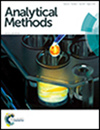
Analytical Methods
分析方法
- 期刊周期:Monthly
- 研究方向:工程技術(shù)
- 影響因子:2.378
- 通訊地址:ROYAL SOC CHEMISTRY, THOMAS GRAHAM HOUSE, SCIENCE PARK, MILTON RD, CAMBRIDGE, ENGLAND, CAMBS, CB4 0WF
- 官網(wǎng):http://pubs.rsc.org/en/journals/journalissues/ay
- 投稿地址:http://mc.manuscriptcentral.com/ay
- 審稿速度:約2.0個月
中文簡介
分析方法歡迎新分析方法和技術(shù)的早期應(yīng)用,這些方法和技術(shù)展示了潛在的社會影響。我們要求發(fā)表在期刊上的方法和技術(shù)必須足夠創(chuàng)新、健壯、準(zhǔn)確,并與預(yù)期應(yīng)用的其他可用方法進(jìn)行比較。特別歡迎跨學(xué)科方法的發(fā)展。系統(tǒng)應(yīng)該用適當(dāng)復(fù)雜且具有分析挑戰(zhàn)性的樣品來證明。我們鼓勵(但不限于)以下技術(shù)和應(yīng)用的發(fā)展:全球衛(wèi)生、護(hù)理點(diǎn)和分子診斷生物傳感器與生物工程藥物開發(fā)與藥物分析應(yīng)用微流體與納米技術(shù)組學(xué)研究,如蛋白質(zhì)組學(xué)、代謝組學(xué)或糖組學(xué)環(huán)境、農(nóng)業(yè)和食品科學(xué)神經(jīng)科學(xué)生化與臨床分析法醫(yī)分析工業(yè)過程與方法開發(fā)
英文簡介
Analytical Methods welcomes early applications of new analytical methods and technology demonstrating potential for societal impact.We require that methods and technology reported in the journal are sufficiently innovative, robust, accurate, and compared to other available methods for the intended application. Developments with interdisciplinary approaches are particularly welcome. Systems should be proven with suitably complex and analytically challenging samples.We encourage developments within, but not limited to, the following technologies and applications:global health, point-of-care and molecular diagnosticsbiosensors and bioengineeringdrug development and pharmaceutical analysisapplied microfluidics and nanotechnologyomics studies, such as proteomics, metabolomics or glycomicsenvironmental, agricultural and food scienceneurosciencebiochemical and clinical analysisforensic analysisindustrial process and method development
近年期刊自引率趨勢圖
JCR分區(qū)
| JCR分區(qū)等級 | JCR所屬學(xué)科 | 分區(qū) | 影響因子 |
| Q1 | SPECTROSCOPY | Q1 | 3.532 |
| CHEMISTRY, ANALYTICAL | Q2 | ||
| FOOD SCIENCE & TECHNOLOGY | Q2 |
近年期刊影響因子趨勢圖
CiteScore數(shù)值
| CiteScore | SJR | SNIP | 學(xué)科類別 | 分區(qū) | 排名 | 百分位 |
| 4.90 | 0.534 | 0.652 | 大類:Engineering 小類:General Engineering | Q1 | 55 / 300 |
81% |
| 大類:Engineering 小類:General Chemical Engineering | Q2 | 81 / 280 |
71% |
|||
| 大類:Engineering 小類:Analytical Chemistry | Q2 | 49 / 130 |
62% |
相關(guān)工程技術(shù)SCI期刊推薦
- SemimonthlyADVANCED MATERIALS
- Journal of Materials Chemistry A
- MonthlyADVANCED FUNCTIONAL MATERIALS
- SemimonthlyAPPLIED CATALYSIS B-ENVIRONMENTAL
- SemimonthlyJOURNAL OF HAZARDOUS MATERIALS
- SemimonthlyJOURNAL OF ALLOYS AND COMPOUNDS
- MonthlyBiotechnology for Biofuels
- Materials Science & Engineering C-Materials for Biological Applications
- MonthlySmall
- MonthlyJOURNAL OF THE ELECTROCHEMICAL SOCIETY
